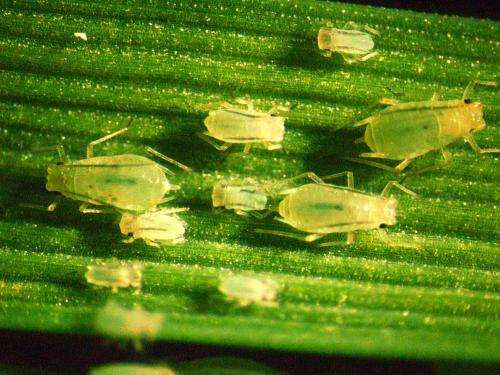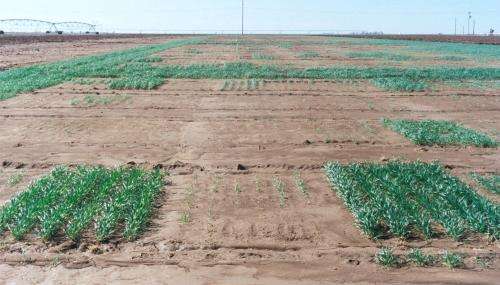Greenbug resistance gene found in wheat

Texas A&M AgriLife Research wheat scientists are getting closer to pinpointing the genes controlling greenbug resistance in wheat and recently published their findings.
Researchers involved in the study were Dr. Srirama Krishna Reddy, Dr. Jackie Rudd and Dr. Shuyu Liu, all with AgriLife Research in Amarillo, and Dr. Yiqun Weng. Weng, formerly with AgriLife Research, designed and started the experiment and is now with the U.S. Department of Agriculture-Agricultural Research Service in Madison, Wis.
The project was supported partially by a U.S. Department of Agriculture National Institute of Food and Agriculture grant, AgriLife Research and Texas Wheat Producers Board.
Most of the hard red winter wheat in the U.S. is cultivated in the Southern Great Plains, where the yields are hampered by several phloem-feeding insects, Rudd said. The primary pest, the greenbug aphid, is estimated to cause economic losses of about $405 million annually.
TAM 112 is currently one of the most popular wheat varieties in Texas and Western Kansas, partially because of good resistance to greenbugs, he said. This research will make it easier to develop more varieties with greenbug resistance.

Using established genomic strategies, the AgriLife Research scientists have identified a set of candidate genes that are associated with greenbug resistance, Liu said.
"This step had not previously been done in greenbug research, so this new identification is an advance in the knowledge of greenbug resistance at the gene level," he said. "It will help us understand the molecular mechanisms of greenbug resistance."
The goal was to identify the genes expressed differently between the known susceptible groups of wheat lines and those showing greenbug resistance, Liu said.
Reddy explained the study, saying it was conducted using Affymetrix GeneChip Wheat Genome Arrays to investigate the gene expression of host defense responses upon greenbug feeding on both resistant and susceptible groups of wheat lines derived from two near-isogenic lines.
"Near-isogenic lines mean that the two lines were similar in all traits except for their nature of resistance to greenbug infestation," Reddy said. "This allows us to identify differentially expressed genes and associate them with greenbug resistance."
The study identified 692 differentially expressed genes between resistant and susceptible groups. Among them, 122 genes were known to be associated with biotic stress responses such as insect feeding, he said.
The resistant group activated more genes related to early defense signaling, which minimizes the feeding damage, Reddy said. In the susceptible lines, more genes related to cell wall stability and basal defense were activated, indicating the greenbugs had caused significant damage during feeding.
Combining this new knowledge with other approaches of gene identification will help the researchers identify and confirm gene-specific markers for greenbug resistance, and then this technology can be utilized by wheat geneticists and breeders, he said.
More information: "Transcriptomics of induced defense responses to greenbug aphid feeding in near isogenic wheat lines" has been accepted for publication in Plant Science. The article can be accessed at www.sciencedirect.com/science/ … ii/S0168945213001702
Provided by Texas A&M University


















